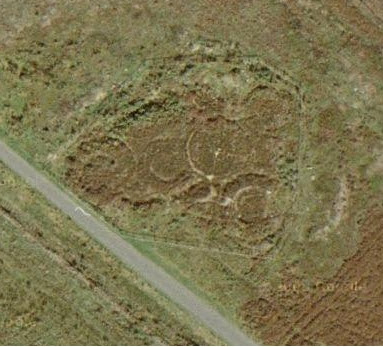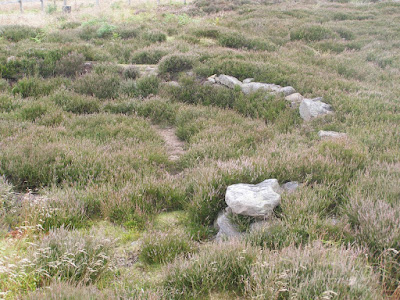
On the hills above Guisborough, the town where I grew up, Google Maps shows these circular structures on Percy Cross Rigg, beside the Kildale Road. In the 1960's an archaeological dig was carried out and revealed the circles to be the bases of round houses and that the site was probably an Iron Age farmstead. The following is a summary of the dig taken from Appendix M of this report on an archaeological site on a golf course at Normanton in West Yorkshire:
Cropmark revealed a sub-rectangular enclosure 100m in length located near the crest of a ridge at 280m OD. Half way along one side of the enclosure an area 50m square was excavated to reveal the platforms and remains of five circular huts which could be divided into three phases of occupation. The earliest phase consisted of two poorly preserved roundhouse structures defined by drip gullies and post holes. The second phase comprised a single hut as above. The latest phase of occupation consisted of two substantial roundhouses 7m in diameter terraced into the hillside. Both were of dry stone wall construction and had the remains of a paved floor and central hearth in situ, surrounded by substantial drainage gullies. A saddle quern, a beehive quern and a fragment of jet bracelet were recovered from the site along with a small amount of local hand made coarse pottery.
Percy Rigg has been interpreted as a small enclosed farmstead. A part from the two different querns which may indicate a long life to the settlement there was no further evidence of cereal processing or storage on the site. Despite further limited trenching within the enclosure no other archaeological features were located.
The pottery assemblage and querns date the beginnings of the settlement to the 4th century BC.
We visited the site on a family walk one weekend when I was about 7 years old. It must have been soon after the excavations had completed because the circular bases were laid bare. Around the outside of each base was a circular drainage ditch (to collect water that has run off the conical roof). On the inner side of each ditch were the lower courses of circular dry-stone walls. The floors of some of the houses were paved with irregular shaped sandstone slabs, and at the centre of each house was a large flat sandstone hearth stone.
For a child, it was fascinating to see the outlines of ancient houses explicitly layed out on the ground like that. You could play games running from house to house, in and out of the doors and round the fireplaces, just as children must have done two thousand years earlier.
Indeed, I was so fascinated that, the following day, I took several of my younger friends on an expedition to revisit the place. To find the way I took a map with me, a fact which seemed to impress some adult hikers who were also visiting the site. Flushed with the success of finding it, I then led my friends on to look for some other archaeological site marked on the map. However, we got lost in some woods and, rather than turn back, I made the decision to go down to the nearest road and walk back to Guisborough along the roads, via Kildale, Easby and Great Ayton. We didn't get home until the early evening, after walking about 10 miles, and having been out all day. Our parents seemed very relieved to see us back.
A few years later the excavations were covered over, the paved floors were hidden and the ditches filled in. Now all that is visible is the tops of the circular dry-stone walls poking up through the heather.

 Fri 2008-12-19
Fri 2008-12-19 
